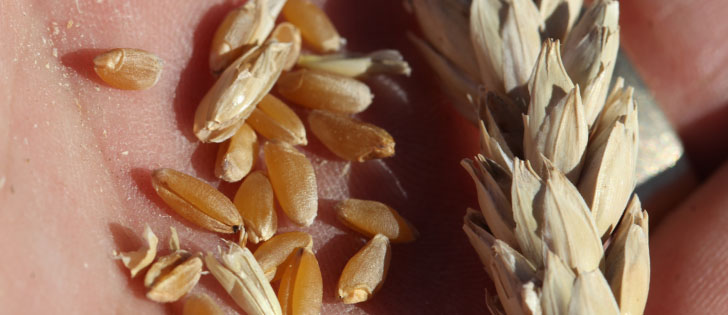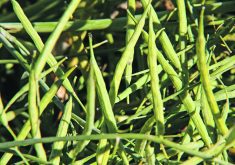Growing grain corn on the Prairies is mostly confined to the usual regions of south central Manitoba and Alberta, but that could soon change.
“There is a lot of interest in corn as another grain crop outside of its traditional area,” said Pam De Rocquigny, chair of the Manitoba Corn Committee, which conducts corn variety trials in that province.
“So much so, we have added a new (set of plots) in Melita.”
Besides the western Manitoba corn trials, De Rocquigny said corn is also grown for grain at Portage la Prairie and in the eastern Red River Valley.
Read Also

August rain welcome, but offered limited relief
Increased precipitation in August aids farmers prior to harvest in southern prairies of Canada.
“Maybe 2009’s weather wasn’t the year for corn, but we’ll have to see how the trials turn out. It’s not a typical prairie growing season.”
Brian Cummings, who represents Monsanto’s prairie corn business, said the market is expanding as the crop is bred to require fewer heat units.
“The Roundup Ready trait is making the corn a crop that farmers aren’t as concerned to try,” he said. “They don’t have the onerous weed control issues they once did and there are so many new traits that are removing yield barriers that as we develop shorter season corn, it opens up new acres.”
Steven King, who supervises breeding of Pioneer Hi-Bred’s newest corn varieties, said prairie farmers often consider corn to be too thirsty a crop for Western Canada.
“I think farmers don’t realize how much water some of their existing crops take out in a season,” he said. “Corn is competitive when it comes to water use and we expect that new drought tolerant traits in the next couple of years will make it even more efficient.”
Cummings said traits such as corn borer resistance are delivering additional benefits, including improved root systems capable of better moisture and nutrient scavenging.
“That sort of trait will go a long way to making corn better suited for the rest of the (Prairies),” he said.
While 2009 might not have been the best year to grow corn, with its cold, cloudy weather, most of the Prairies south of the 52nd parallel receive an average of 2,100 corn heat units annually, with large areas receiving 2,600 to 2,800 units. In most years, this is enough to produce the latest short season grain corn varieties.
Pioneer research director Dave Charne said corn needs additional breeding to achieve the rapid start needed to reach maturity before harvest, such as the ability to withstand cold shocks mid season and improved tolerance to cold soil at seeding.
“We’re pulling some exotic germplasm from work the company has done in Russia and (Eastern) Europe where similar conditions exist,” he said.
Pioneer has a 72-day-to-maturity grain corn hybrid and says the future of a 65-day hybrid is nearly certain in the next few years.
David Townsend of Syngenta Seeds Canada said his company has expanded its breeding program and has two new series of hybrids that fall into the 2,150 to 2,200 heat unit range. He said they perform well in Manitoba and Alberta and have potential outside traditional areas.
Townsend plans to put three or four “fully traited” versions of lower heat unit corn hybrids that are aimed at the Prairies onto the market in the next five years.
Ian Grant, who heads Pioneer Hi-Bred in Canada, said producers need to understand the agronomy of corn to ensure success.
The company refurbished six used John Deere model 7000 corn planters from Ontario and loaned four of them to growers in Saskatchewan, one in Manitoba and one in Alberta.
“If we don’t get the tools into their hands, they won’t be able to experience it or share that (experience) with their neighbours,” he said.
De Rocquigny said successful examples for producers to observe in non-traditional areas are critical to building an awareness of the opportunity for grain corn.
“Even for silage, much of the feed value is in the cob; you need that maturity for silage too,” she said.
Grain corn trials of varieties rated below 2,150 corn heat units in Mac-Gregor, Man., delivered grain yields of 135 to 182 bushels per acre, with three year averages of 144 and 183 bu. The 2008 crop was seeded May 14 and harvested Oct. 15.
“It was a fairly open fall, after a cool summer,” de Rocquigny said.
Darcy Rafoss of Pioneer said the company is offering its independent dealers a financing plan so they will be able to buy planters to provide to their customers for next year.
“Precision placement of seed, both depth and spacing, is critical to success with corn,” he said.
“With an air seeder, it is tough to get that just right, but these mechanical planters are reliable and can get that job done…. It adds a pretty big yield boost to have that seed placed just right.”
Townsend said research in Ontario has found that the best air seeders being used in the West have potential to produce decent yields.
“The stands look like heck, but they are yielding well, so there is potential to use the same gear farmers already have and that will go a long way to getting more grain corn grown.”
He said Western Canada also has the advantage of soil that is naturally high in potash, giving it a fertilizer cost advantage over other growing areas.
This year, prairie corn that was planted later in the spring matured faster and is taller than that of the earlier seeded crop. This applies to other crops as well.
Townsend said this is because corn is especially fussy about cold soil when it emerges, so getting it into soil that is as free of trash as possible can be an advantage. Planting it when soil is warmer is another option.
He said new technology in the form of strip tillage is creating new ways to warm soil without large scale soil disturbance.
“Corn likes a soil at 45 to 50 F (7 to 10 C). We tend to offer our crops 40 to 50 F (4 to 10 C), so we need to address that through agronomy.”
What’s a corn heat unit?
Corn heat units for hybrids are not an independent measure. They are a measure of relative maturity.
Each company uses its own definition, so the measure varies between breeders and seed suppliers.
However, most companies agree that much of the southern Prairies has enough corn heat units to support grain corn production as breeders adapt the latest genetics into shorter season varieties.
Other issues to consider when choosing a corn series are the 50 percent silking date, grain density in pounds per bushel and moisture percent at harvest. These are available from the Alberta and Manitoba provincial corn trials.
For more information about short season grain corn, contact:
Monsanto: 800-667-4944 or www.monsanto.ca.
Pickseed Canada: 204-633-0088 or www.pickseed.com.
Pioneer Hi-Bred: 204-745-6024 or www.pioneer.com/canada.
Pride Seeds: 800-255-5280 or www.prideseed.com.
Brett Young: 204-261-7932 or www.brett young.ca.
Gowan Seeds: 204-822-9106.
Hyland Seeds: 204-745-7656.
Maizex Seeds: 877-682-1720.
Quarry Grain: 888-274-9243 or www.quarrygrain.com.
Alberta Corn Committee: www.albertacorn.com/.
Syngenta Seeds: 888-756-7333 or www.nkcanada.com.
Manitoba Corn Growers: www.manitobacorn.ca/mcc.html.














